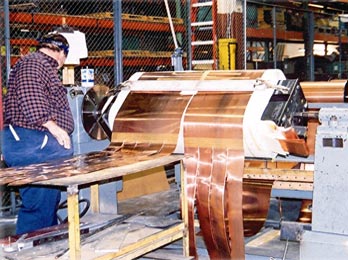
Dry-Type disc wound transformers in MV applications
Medium voltage, dry-type transformers may have their high voltage windings constructed using either the layer winding technique or the disc winding technique.
Both winding techniques provide the same result in terms of electrical performance parameters, i.e. turns ratio, impedance etc.
However, the use of transformers employing disc wound high voltage windings can result in increased reliability and therefore reduced downtime.
Introduction
The basic purpose of a transformer is to convert electricity at one voltage to electricity at another voltage, either of higher or lower value. In order to achieve this voltage conversion, coils are wound on a laminated silicon steel core which provides a path for the magnetic flux. The coils comprise a number of turns of conductor, either copper or aluminum, wound as two electrically separate windings, called the primary winding and the secondary winding. The primary winding is connected to the source of voltage while the secondary winding is connected to the load. The ratio of primary to secondary turns is the same as the required ratio of primary to secondary voltages.
The turns of conductor forming the primary and secondary windings must be insulated from one another, while the primary winding must be insulated from the secondary winding and both the primary and secondary windings must be insulated from ground. The insulation of turns and windings is collectively called the insulation system of the transformer. The insulation system must be designed to withstand the effects of lightning strikes and switching surges to which the transformer is subjected, in addition to the normal operating voltages. A further requirement of the insulation system is that it must withstand the environmental conditions to which it is exposed, such as moisture, dust etc. A variety of techniques and materials are employed to achieve the necessary performance characteristics of the insulation system.
Layer winding

Fig.1 Layer winding
For low voltage, i.e. 600 Volt class windings, the winding technique used almost exclusively is the layer winding technique, also sometimes called helical winding or barrel winding. In this technique, the turns required for the winding are wound in one or more concentric layers connected in series, with the turns of each layer being wound side by side along the axial length of the coil until the layer is full. The conductors of the winding are insulated and so between turns there will be a minimum of two thicknesses of insulation. Between each pair of layers there will be layers of insulation material and/or an air duct.
Low voltage windings will generally be wound top to bottom, bottom to top etc. using a continuous conductor, until all layers are complete. High voltage windings, i.e. above 600 Volt class, may be wound in the same way, provided the voltage between layers is not too great.
To reduce the voltage stress between layers, high voltage windings are often wound in only one direction, for example, top to bottom. When the first layer of winding is complete, the winding conductor is laid across the completed layer from bottom to top and then the next layer is wound, again from top to bottom. In this way, the voltage stress between layers is halved.
The conductor must, of course, have additional insulation where it crosses the winding from bottom to top.

Fig.2 Transformer with layer wound coils
Disc winding
In the disc winding, the required number of turns are wound in a number of horizontal discs spaced along the axial length of the coil. The conductor is usually rectangular in cross-section and the turns are wound in a radial direction, one on top of the other i.e. one turn per layer, until the required number of turns per disc has been wound.

Fig.3 Disc winding
The conductor is then moved to the next disc and the process repeated until all turns have been wound. There is an air space, or duct, between each pair of discs. The disc winding requires insulation only on the conductor itself, no additional insulation is required between layers, as in the layer winding.
The disc wound high voltage winding is usually wound in two halves, in order that the required voltage adjustment taps may be positioned at the electrical center of the winding. In this way the magnetic, or effective length of the winding is maintained, irrespective of which tap is used, and therefore the magnetic balance between primary and secondary windings is always close to its optimum.
This is essential to maintain the short circuit strength of the winding, and reduces the axial electromagnetic forces which arise when the windings are not perfectly balanced.

Fig.4 Transformer with disc wound coils
Characteristics of Layer wound coils
As stated previously, the layer wound coil requires insulation between layers, in addition to the conductor insulation. The thickness of insulation required will depend upon the voltage stress between layers, and comprises one or more thicknesses of the appropriate insulation material. In practice, due to the nature of the construction of a layer wound coil, the finished coil will have several unavoidable small air pockets between turns and between layers. Many of these air pockets will become filled with resin during vacuum pressure impregnation of the coil.

Fig. 5 Equivalent circuit for Impulse voltage distribution
However, it sometimes happens that some air pockets remain and it is in these air pockets that partial discharges can occur, greatly increasing the possibility of premature aging of the insulation and eventual failure.
Catastrophic failure can occur within a few months of energization. Under short circuit conditions, the electromagnetic forces developed cause transformer windings to attempt to telescope. At the same time the coil end blocking is trying to prevent movement. The result is often that the turns of the winding have a tendency to slip over one another, causing turn-to turn failure, due to abrasion of the insulation as the turns rub together. A further disadvantage of the layer wound coil is its poor impulse voltage distribution between the first few turns of the winding, due to the high ground capacitance and the low series capacitance.
A transformer winding forms a complex network of resistance, inductance and capacitance. As far as the impulse voltage distribution is concerned, the resistance can be ignored and at the instant of application of the impulse wave, when very high frequencies are predominant, the inductive elements become effectively infinite impedances. The whole structure therefore reduces to a capacitive network (see fig.5). Each turn of a transformer winding is insulated with a dielectric material and can be thought of as one plate of a multiple plate capacitor. In addition, the combination of dielectric material and air between each turn and ground forms further capacitive elements.
Characteristics of Disc wound coils
The major advantage of the disc wound coil lies in its open construction and relative lack of insulation. For a 15kV class transformer employing a disc wound primary winding, the number of discs will typically be in the range 36 to 48, resulting in a relatively low voltage per disc. Since each disc is separated from the next by an air space, the voltage stress between discs can easily be handled by the combination of conductor insulation and air, no additional insulation being necessary.
Each disc comprises a number of turns with each turn occupying one layer, i.e. one turn per layer: the voltage stress between layers is therefore the same as the voltage stress between turns and again, can easily be handled by the conductor insulation. The turns of each disc, being wound tightly together provide almost no possibility of air pockets being present within the disc.
Due to the open construction of the discs, any small air pockets which may be present are readily filled with resin during vacuum pressure impregnation of the coil. A properly designed and manufactured dry-type transformer disc winding therefore displays very low values of partial discharge, typically in the range 10 to 20 picocoulombs.
Unlike the layer wound coil, the disc wound coil provides good impulse voltage distribution, due to its inherently low value of ground capacitance and high series capacitance. The disc wound coil also displays excellent short circuit strength. Each disc by itself is mechanically very strong and the complete assembly of discs are held very securely in place. While the electromagnetic forces resulting from a short circuit result in a tendency, for the windings to telescope, the high voltage turns usually remain intact relative to each other. Instead, the complete disc has a tendency to distort as an assembly, with all the turns distorting by the same amount. The transformer can often continue to function, despite the distortion, until a convenient time arises for repair.
Losses/heat
The flow of electric current through the turns of a transformer winding causes power losses which manifest themselves in the form of heat. These losses are called ‘’load losses’’ and are proportional to the square of the current. Obviously, it is necessary to dissipate this heat, to prevent overheating of the transformer, and in a dry-type transformer, this is achieved by the use of air spaces, or ducts, within the winding. The layer wound coil relies on vertical air ducts between layers and between windings, for cooling. Cool air enters the air ducts at the bottom of the coil and by natural convection, rises through the ducts, collecting heat on its way, then exits the coil at the top. It is essential for proper operation of the transformer that these air ducts are kept clear at all times.
The insulation required between the layers of a layer wound coil has a tendency to thermally lag the winding, impeding the dissipation of heat. The greater the operating voltage of the winding, the greater is the amount of insulation required and the greater is the lagging effect of the insulation. Some radiation also takes place from the outer surfaces of the coils. The open nature of the disc wound coil greatly improves the transfer of heat from the winding to the surrounding air. The thermal lagging effect of insulation is removed and the multiple horizontal air spaces between discs provide a large surface area for cooling by both radiation and convection.
Conclusions
The combination of layer wound low voltage winding, disc wound high voltage winding, NOMEX insulation and vacuum pressure impregnation of the windings with a solventless epoxy resin, results in a very reliable transformer with a long life expectancy. Transformers constructed in this way will be relatively free from partial discharge and will provide excellent impulse strength and short circuit strength, vital requirements for reliable operation in the most demanding of applications.
.
Author: Derek Foster, Olsun Electrics Corporation
.
Related articles
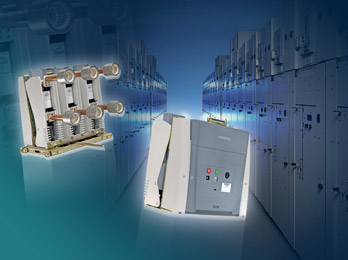
Maintenance Of Meduim Voltage Circuit Breakers
Medium-voltage circuit breakers rated between 1 and 72 kV may be assembled into metal-enclosed switchgear line ups for indoor use, or may be individual components installed outdoors in a substation. Air-break circuit breakers replaced oil-filled units for indoor applications, but are now themselves being replaced by vacuum circuit breakers (up to about 35 kV).
Medium voltage circuit breakers which operate in the range of 600 to 15,000 volts should be inspected and maintained annually or after every 2,000 operations, whichever comes first.
The above maintenance schedule is recommended by the applicable standards to achieve required performance from the breakers.
.
Safety Practices
Maintenance procedures include the safety practices indicated in the ROMSS (Reclamation Operation & Maintenance Safety Standards) and following points that require special attention.
- Be sure the circuit breaker and its mechanism are disconnected from all electric power, both high voltage and control voltage, before it is inspected or repaired.
- Exhaust the pressure from air receiver of any compressed air circuit breaker before it is inspected or repaired.
- After the circuit breaker has been disconnected from the electrical power, attach the grounding leads properly before touching any of the circuit breaker parts.
- Do no lay tools down on the equipment while working on it as they may be forgotten when the equipment is placed back in service.
.
Maintenance Procedures For Medium Voltage Air Circuit Breakers
The following suggestions are for use in conjunction with manufacturer’s instruction books for the maintenance of medium voltage air circuit breakers:
- Clean the insulating parts including the bushings.
- Check the alignment and condition of movable and stationary contacts and adjust them per the manufacturer’s data.
- See that bolts, nuts, washers, cotter pins, and all terminal connections are in place and tight.
- Check arc chutes for damage and replace damaged parts.
- Clean and lubricate the operating mechanism and adjust it as described in the instruction book. If the operating mechanism cannot be brought into specified tolerances, it will usually indicate excessive wear and the need for a complete overhaul.
- Check, after servicing, circuit breaker to verify that contacts move to the fully opened and fully closed positions, that there is an absence of friction or binding, and that electrical operation is functional.
.
Maintenance Procedures For Medium Voltage Oil Circuit Breakers
The following suggestions are for use in conjunction with the manufacturer’s instruction books for the maintenance of medium-voltage oil circuit breakers:
- Check the condition, alignment, and adjustment of the contacts.
- Thoroughly clean the tank and other parts which have been in con tact with the oil.
- Test the dielectric strength of the oil and filter or replace the oil if the dielectric strength is less than 22 kV. The oil should be filtered or replaced whenever a visual inspection shows an excessive amount of carbon, even if the dielectric strength is satisfactory.
- Check breaker and operating mechanisms for loose hardware and missing or broken cotter pins, retain ing rings, etc.
- Adjust breaker as indicated in instruction book.
- Clean and lubricate operating mechanism.
- Before replacing the tank, check to see there is no friction or binding that would hinder the breaker’s operation. Also check the electrical operation. Avoid operating the breaker any more than necessary without oil in the tank as it is designed to operate in oil and mechanical damage can result from excessive operation without it.
- When replacing the tank and refilling it with oil, be sure the gaskets are undamaged and all nuts and valves are tightened properly to prevent leak age.
.
Maintenance Procedures For Medium Voltage Vacuum Circuit Breakers
Direct inspection of the primary contacts is not possible as they are enclosed in vacuum containers. The operating mechanisms are similar to the breakers discussed earlier and may be maintained in the same manner. The following two maintenance checks are suggested for the primary contacts:
- Measuring the change in external shaft position after a period of use can indicate extent of contact erosion. Consult the manufacturer’s instruction book.
- Condition of the vacuum can be checked by a hipot test. Consult the manufacturer’s instruction book.
.
SOURCE: MAINTENANCE OF POWER CIRCUIT BREAKERS by HYDROELECTRIC RESEARCH AND TECHNICAL SERVICES GROUP
.
Related articles
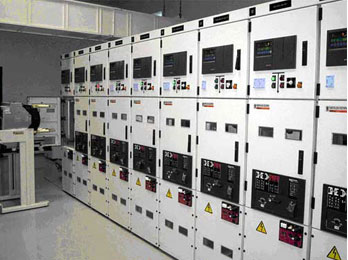
What CB to use? Vacuum or SF6 circuit breaker?
Until recently oil circuit breakers were used in large numbers for Medium voltage Distribution system in many medium voltage switchgears. There are number of disadvantages of using oil as quenching media in circuit breakers. Flammability and high maintenance cost are two such disadvantages! Manufacturers and Users were forced to search for different medium of quenching. Air blast and Magnetic air circuit breakers were developed but could not sustain in the market due to other disadvantages associated with such circuit breakers. These new types of breakers are bulky and cumbersome. Further research were done and simultaneously two types of breakers were developed with SF6 as quenching media in one type and Vacuum as quenching media in the other. These two new types of breakgasers will ultimately replace the other previous types completely shortly. There are a few disadvantages in this type of breakers also. One major problem is that the user of the breakers are biased in favour of old fashioned oil circuit breakers and many of the users always have a step motherly attitude to the new generations of the breakers. However in due course of time this attitude will disappear and the new type of breakers will get its acceptance among the users and ultimately they will completely replace the oil circuit breakers. An attempt is made to make a comparison between the SF6 type and vacuum type circuit breakers with a view to find out as to which of the two types is superior to the other. We will now study in detail each type separately before we compare them directly.
Vacuum Circuit Breaker
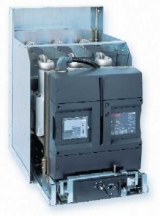
Evolis MV Circuit Breaker
In a Vacuum circuit breaker, vacuum interrupters are used for breaking and making load and fault currents. When the contacts in vacuum interrupter separate, the current to be interrupted initiates a metal vapour arc discharge and flows through the plasma until the next current zero. The arc is then extinguished and the conductive metal vapour condenses on the metal surfaces within a matter of micro seconds. As a result the dielectric strength in the breaker builds up very rapidly.
The properties of a vacuum interrupter depend largely on the material and form of the contacts. Over the period of their development, various types of contact material have been used. At the moment it is accepted that an oxygen free copper chromium alloy is the best material for High voltage circuit breaker. In this alloy , chromium is distributed through copper in the form of fine grains. This material combines good arc extinguishing characteristic with a reduced tendency to contact welding and low chopping current when switching inductive current. The use of this special material is that the current chopping is limited to 4 to 5 Amps.
At current under 10KA, the Vacuum arc burns as a diffuse discharge. At high values of current the arc changes to a constricted form with an anode spot. A constricted arc that remain on one spot for too long can thermically over stress the contacts to such a degree that the deionization of the contact zone at current zero can no longer be guaranteed . To overcome this problem the arc root must be made to move over the contact surface. In order to achieve this, contacts are so shaped that the current flow through them results in a magnetic field being established which is at right angles to the arc axis. This radial field causes the arc root to rotate rapidly around the contact resulting in a uniform distribution of the heat over its surface. Contacts of this type are called radial magnetic field electrodes and they are used in the majority of circuit breakers for medium voltage application.
A new design has come in Vacuum interrupter, in which switching over the arc from diffusion to constricted state by subjecting the arc to an axial magnetic field. Such a field can be provided by leading the arc current through a coil suitably arranged outside the vacuum chamber. Alternatively the field can be provided by designing the contact to give the required contact path. Such contacts are called axial magnetic field electrodes. This principle has advantages when the short circuit current is in excess of 31.5 KA.
SF6 Gas Circuit Breaker
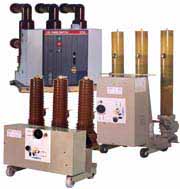
SF6 circuit breakers
In an SF6 circuit-breaker, the current continues to flow after contact separation through the arc whose plasma consists of ionized SF6 gas. For, as long as it is burning, the arc is subjected to a constant flow of gas which extracts heat from it. The arc is extinguished at a current zero, when the heat is extracted by the falling current. The continuing flow of gas finally de-ionises the contact gap and establishes the dielectric strength required to prevent a re-strike.
The direction of the gas flow, i.e., whether it is parallel to or across the axis of the arc, has a decisive influence on the efficiency of the arc interruption process. Research has shown that an axial flow of gas creates a turbulence which causes an intensive and continuous interaction between the gas and the plasma as the current approaches zero. Cross-gas-flow cooling of the arc is generally achieved in practice by making the arc move in the stationary gas. This interruption process can however, lead to arc instability and resulting great fluctuations in the interrupting capability of the circuit breaker.
In order to achieve a flow of gas axially to the arc a pressure differential must be created along the arc. The first generation of the SF6 circuit breakers used the two-pressure principle of the air-blast circuit-breaker. Here a certain quantity of gas was kept stored at a high pressure and released into the arcing chamber. At the moment high pressure gas and the associated compressor was eliminated by the second generation design. Here the pressure differential was created by a piston attached to the moving contacts which compresses the gas in a small cylinder as the contact opens. A disadvantage is that this puffer system requires a relatively powerful operating mechanism.
Neither of the two types of circuit breakers described was able to compete with the oil circuit breakers price wise. A major cost component of the puffer circuit-breaker is the operating mechanism; consequently developments followed which were aimed at reducing or eliminating this additional cost factor. These developments concentrated on employing the arc energy itself to create directly the pressure-differential needed. This research led to the development of the self-pressuring circuit-breaker in which the over – pressure is created by using the arc energy to heat the gas under controlled conditions. During the initial stages of development, an auxiliary piston was included in the interrupting mechanism, in order to ensure the satisfactory breaking of small currents. Subsequent improvements in this technology have eliminated this requirement and in the latest designs the operating mechanism must only provide the energy needed to move the contacts.
Parallel to the development of the self-pressuring design, other work resulted in the rotating – arc SF6 gas circuit breaker. In this design the arc is caused to move through, in effect the stationery gas. The relative movement between the arc and the gas is no longer axial but radial, i.e., it is a cross-flow mechanism. The operating energy required by circuit breakers of this design is also minimal.
Table 1. Characteristics of the SF6 and vacuum current interrupting technologies.
| SF6 Circuit Breakers | Vacuum Circuit Breakers | ||
| Criteria | Puffer Circuit Breaker | Self-pressuring circuit-breaker | Contact material-Chrome-Copper |
| Operating energy requirements | Operating Energy requirements are high, because the mechanism must supply the energy needed to compress the gas. | Operating Energy requirements are low, because the mechanism must move only relatively small masses at moderate speed, over short distances. The mechanism does not have to provide the energy to create the gas flow | Operating energy requirements are low, because the mechanism must move only relatively small masses at moderate speed, over very short distances. |
| Arc Energy | Because of the high conductivity of the arc in the SF6 gas, the arc energy is low. (arc voltage is between 150 and 200V.) | Because of the very low voltage across the metal vapour arc, energy is very low. (Arc voltage is between 50 and 100V.) | |
| Contact Erosion | Due to the low energy the contact erosion is small. | Due to the very low arc energy, the rapid movement of the arc root over the contact and to the fact that most of the metal vapour re-condenses on the contact, contact erosion is extremely small. | |
| Arc extinguishing media | The gaseous medium SF6 possesses excellent dielectric and arc quenching properties. After arc extinction, the dissociated gas molecules recombine almost completely to reform SF6. This means that practically no loss/consumption of the quenching medium occurs. The gas pressure can be very simply and permanently supervised. This function is not needed where the interrupters are sealed for life. | No additional extinguishing medium is required. A vacuum at a pressure of 10-7 bar or less is an almost ideal extinguishing medium. The interrupters are ‘sealed for life’ so that supervision of the vacuum is not required. | |
| Switching behavior in relation to current chopping | The pressure build-up and therefore the flow of gas is independent of the value of the current. Large or small currents are cooled with the same intensity. Only small values of high frequency, transient currents, if any, will be interrupted. The de-ionization of the contact gap proceeds very rapidly, due to the electro-negative characteristic of the SF6 gas and the arc products. | The pressure build-up and therefore the flow of gas is dependent upon the value of the current to be interrupted. Large currents are cooled intensely, small currents gently. High frequency transient currents will not, in general, be interrupted. The de-ionization of the contact gap proceeds very rapidly due to the electro-negative characteristic of the SF6 gas and the products. | No flow of an ‘extinguishing’ medium needed to extinguish the vacuum arc. An extremely rapid de-ionization of the contact gap, ensures the interruption of all currents whether large or small. High frequency transient currents can be interrupted. The value of the chopped current is determined by the type of contact material used. The presence of chrome in the contact alloy with vacuum also. |
| No. of short-circuit operation | 10—50 | 10—50 | 30—100 |
| No. full load operation | 5000—10000 | 5000—10000 | 10000—20000 |
| No. of mechanical operation | 5000—20000 | 5000—20000 | 10000—30000 |
Comparison of the SF6 And Vacuum Technologies
The most important characteristics of the SF6 gas and vacuum-circuit breakers, i.e., of SF6 gas and vacuum as arc-extinguishing media are summarized in Table-1.
In the case of the SF6 circuit-breaker, interrupters which have reached the limiting number of operations can be overhauled and restored to ‘as new’ condition. However, practical experience has shown that under normal service conditions the SF6 interrupter never requires servicing throughout its lifetime. For this reason, some manufacturers no longer provide facilities for the user to overhaul the circuit-breaker, but have adopted a ‘sealed for life’ design as for the vacuum-circuit breaker.
The operating mechanisms of all types of circuit-breakers require servicing, some more frequently than others depending mainly on the amount of energy they have to provide. For the vacuum-circuit breaker the service interval lies between 10,000 and 20,000 operations. For the SF6 designs the value varies between 5,000 and 20,000 whereby, the lower value applies to the puffer circuit-breaker for whose operation, the mechanism must deliver much more energy.
The actual maintenance requirements of the circuit-breaker depend upon its service duty, i.e. on the number of operations over a given period of time and the value of current interrupted. Based on the number of operations given in the previous section, it is obvious that SF6 and vacuum circuit-breakers used in public supply and /or industrial distribution systems will, under normal circumstances, never reach the limits of their summated breaking current value. Therefore, the need for the repair or replacement of an interrupter will be a rare exception and in this sense these circuit-breakers can be considered maintenance-free. Service or maintenance requirements are therefore restricted to routine cleaning of external surfaces and the checking and lubrication of the mechanism, including the trip-linkages and auxiliary switches. In applications which require a very high number of circuit-breaker operations e.g. for arc furnace duty or frequently over the SF6 design, due to its higher summated-breaking current capability. In such cases it is to be recommended that the estimation of circuit-breaker maintenance costs be given some consideration and that these be included in the evaluation along with the initial, capital costs.
Reliability
In practice, an aspect of the utmost importance in the choice of a circuit-breaker is reliability.
The reliability of a piece of equipment is defined by its mean time to failure (MTF), i.e. the average interval of time between failures. Today, the SF6 and vacuum circuit-breakers made use of the same operating mechanisms, so in this regard they can be considered identical.
However, in relation to their interrupters the two circuit breakers exhibit a marked difference. The number of moving parts is higher for the SF6 circuit-breaker than that for the vacuum unit. However, a reliability comparison of the two technologies on the basis of an analysis of the number of components are completely different in regards design, material and function due to the different media. Reliability is dependent upon far too many factors, amongst others, dimensioning, design, base material, manufacturing methods, testing and quality control procedures, that it can be so simply analyzed.
In the meantime, sufficient service experience is available for both types of circuit-breakers to allow a valid practical comparison to be made. A review of the available data on failure rates confirms that there is no discernible difference in reliability between the two circuit-breaker types. More over, the data shows that both technologies exhibit a very high degree of reliability under normal and abnormal conditions.
Switching of fault currents
Today, all circuit-breakers from reputable manufacturers are designed and type-tested in conformance with recognized national or international standards (IEC56). This provides the assurance that these circuit-breakers will reliably interrupt all fault currents up to their maximum rating. Further, both types of circuit-breakers are basically capable of interrupting currents with high DC components; such currents can arise when short circuits occur close to a generator. Corresponding tests have indeed shown that individual circuit-breakers of both types are in fact, capable of interrupting fault currents with missing current zeros i.e. having a DC component greater than 100 per cent. Where such application is envisaged, it is always to be recommended that the manufacturer be contacted and given the information needed for a professional opinion.
As regards the recovery voltage which appears after the interruption of a fault current the vacuum-circuit breaker can, in general, handle voltages with RRV values of up to 5KV. SF6 circuit-breakers are more limited, the values being in the range from 1 to 2 KV. In individual applications, e.g. in installations with current limiting chokes or reactors, etc., With SF6 circuit-breakers it may be advisable or necessary to take steps to reduce that rate of rise of the transient recovery voltage.
Switching small inductive currents
The term, small inductive currents is here defined as those small values of almost pure inductive currents, such as occur with unloaded transformers, motor during the starting phase or running unloaded and reactor coils. When considering the behavior of a circuit-breaker interrupting such currents, it is necessary to distinguish between high frequency and medium frequency transient phenomena.
Medium frequency transients arise from, amongst other causes, the interruption of a current before it reaches its natural zero. All circuit-breakers can, when switching currents of the order of a few hundred amperes and, due to instability in the arc, chop the current immediately prior to a current zero.
This phenomenon is termed real current chopping. When it occurs, the energy stored in the load side inductances oscillates through the system line to earth capacitances (winding and cable capacitances) and causes an increase in the voltage. This amplitude of the resulting over voltage is a function of the value of the current chopped. The smaller the chopped current, the lower the value of the over voltage.
In addition to the type of circuit – breaker, the system parameters at the point of installation are factors which determine the height of the chopping current, in particular the system capacitance parallel to the circuit breaker is of importance. The chopping current of SF6 circuit-breakers is essentially determined by the type of circuit-breaker. The value of chopping current varies from 0.5A to 15A, whereby the behavior of the self – pressuring circuit-breaker is particularly good, its chopping current being less than 3A.This ‘soft’
Switching feature is attributable to the particular characteristics of the interrupting mechanism of the self-pressuring design and to the properties of the SF6 gas itself.
In the early years of the development of the vacuum circuit-breaker the switching of small inductive currents posed a major problem, largely due to the contact material in use at that time. The introduction of the chrome copper contacts brought a reduction of the chopping current to between 2 to 5A.The possibility of impermissible over voltages arising due to current chopping has been reduced to a negligible level.
High frequency transients arise due to pre- or re-striking of the arc across the open contact gap. If, during an opening operation, the rising voltage across the opening contacts, exceed the dielectric strength of the contact gap , a re-strike occurs. The high-frequency transient current arising from such a re-strike can create high frequency current zeros causing the circuit-breaker to, interrupt again. This process can cause a further rise in voltage and further re-strikes. Such an occurrence is termed as multiple restriking.
With circuit- breakers that can interrupt high frequency transient currents, re-striking can give rise to the phenomenon of virtual current chopping. Such an occurrence is possible when a re-strike in the first-phase-to-clear, induces high frequency transients in the other two phases, which are still carrying service frequency currents. The superimposition of this high frequency oscillation on the load current can cause an apparent current zero and an interruption by the circuit-breaker, although the value of load current may be quite high. This phenomenon is called virtual current chopping and can result in a circuit breaker ‘chopping’ very much higher values of current than it would under normal conditions. The results of virtual current chopping are over-voltages of very high values.
This phenomenon is termed real current chopping. When it occurs, the energy Stored in the load side inductances oscillates through the system line to earth capacitances (winding and cable capacitances) and causes an increase in the voltage. This amplitude of the resulting over voltage is a function of the value of the current chopped. The smaller the chopped current, the lower the value of the over voltage.
In addition to the type of circuit – breaker, the system parameters at the point of installation are factors which determine the height of the chopping current, in particular the system capacitance parallel to the circuit breaker is of importance. The chopping current of SF6 circuit-breakers is essentially determined by the type of circuit-breaker. The value of chopping current varies from 0.5A to 15A, whereby the behaviour of the self – pressuring circuit-breaker is particularly good, its chopping current being less than 3A.This ‘soft’ Switching feature is attributable to the particular characteristics of the interrupting mechanism of the self-pressuring design and to the properties of the SF6 gas itself.
In the early years of the development of the vacuum circuit-breaker the switching of small inductive currents posed a major problem, largely due to the contact material in use at that time. The introduction of the chrome copper contacts brought a reduction of the chopping current to between 2 to 5A.The possibility of impermissible over voltages arising due to current chopping has been reduced to a negligible level.
High frequency transients arise due to pre- or re-striking of the arc across the open contact gap. If, during an opening operation, the rising voltage across the opening contacts exceeds the dielectric strength of the contact gap, a re-strike occurs. The high-frequency transient current arising from such a re-strike can create high frequency current zeros causing the circuit-breaker to, interrupt again. This process can cause a further rise in voltage and further re-strikes. Such an occurrence is termed as multiple re-striking.
With circuit- breakers that can interrupt high frequency transient currents, re-striking can give rise to the phenomenon of virtual current chopping. Such an occurrence is possible when a re-strike in the first-phase-to-clear, induces high frequency transients in the other two phases, which are still carrying service frequency currents. The superimposition of this high frequency oscillation on the load current can cause an apparent current zero and an interruption by the circuit-breaker, although the value of load current may be quite high. This phenomenon is called virtual current chopping and can result in a circuit breaker ‘chopping’ very much higher values of current than it would under normal conditions. The results of virtual current chopping are over-voltages of very high values
Table2. Comparison of the SF6 And Vacuum Technologies In Relation To Operational Aspects
| Criteria | SF6 Breaker | Vacuum Circuit Breaker |
| Summated current cumulative | 10-50 times rated short circuit current | 30-100 times rated short circuit current |
| Breaking current capacity of interrupter | 5000-10000 times | 10000-20000 times |
| Mechanical operating life | 5000-20000 C-O operations | 10000-30000 C-O operations |
| No operation before maintenance | 5000-20000 C-O operations | 10000-30000 C-O operations |
| Time interval between servicing Mechanism | 5-10 years | 5-10 years |
| Outlay for maintenance | Labour cost High, Material cost Low | Labour cost Low, Material cost High |
| Reliability | High | High |
| Dielectric withstand strength of the contact gap | High | Very high |
Very extensive testing has shown that, because of its special characteristics the SF6 self-pressuring circuit-breaker possesses considerable advantages in handling high frequency transient phenomena, in comparison with both the puffer type SF6 and the vacuum circuit breakers. The past few years have seen a thorough investigation of the characteristics of vacuum circuit breakers in relation to phenomena such as multiple re-striking and virtual current chopping. These investigations have shown that the vacuum circuit-breaker can indeed cause more intense re-striking and hence more acute over voltages than other types. However, these arise only in quite special switching duties such as the tripping of motors during starting and even then only with a very low statistical probability. The over-voltages which are created in such cases can be reduced to safe levels by the use of metal oxide surge diverters.
Table3. Comparison of the SF6 And Vacuum Switching Technologies In Relation To Switching Applications
| Criteria | SF6 Circuit Breaker | Vacuum Circuit Breaker |
| Switching of Short circuit current with High DC component | Well suited | Well suited |
| Switching of Short circuit current with High RRV | Well suited under certain conditions (RRV>1-2 kV per Milli seconds | Very well suited |
| Switching of transformers | Well suited. | Well suited |
| Switching of reactors | Well suited | Well suited. Steps to be taken when current <600A. to avoid over voltage due to current chopping |
| Switching of capacitors | Well suited. Re-strike free | Well suited. Re-strike free |
| Switching of capacitors back to back | Suited. In some cases current limiting reactors required to limit inrush current | Suited. In some cases current limiting reactors required to limit inrush current |
| Switching of arc furnace | Suitable for limited operation | Well suited. Steps to be taken to limit over voltage. |
.





